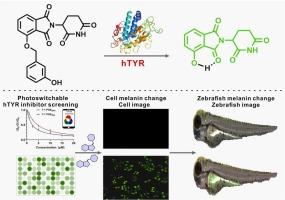Visual fluorescence discovery of the potent photoswitchable hTYR inhibitor to improve treatment strategy for hyperpigmentation
IF 3.7
1区 化学
Q1 CHEMISTRY, ANALYTICAL
引用次数: 0
Abstract
Hyperpigmentation, which is caused by excess melanin production by melanocytes with human tyrosinase (hTYR) playing a pivotal role, can lead to various dermatological disorders. Therefore, the discovery and utilization of novel human tyrosinase inhibitors represent a promising therapeutic strategy. Herein, a new fluorescent probe THT-1 was developed for the first time to recognize human tyrosinase instead of mushroom tyrosinase based on the thalidomide fluorescent skeleton. This green probe can not only screen for novel photoswitchable indole-2-ketone-based human tyrosinase inhibitors with better visual sensitivity, but also effectively recognize endogenous tyrosinase at both cellular and zebrafish levels. By meticulously monitoring fluorescence intensity variations, the impact of photoswitchable inhibitors on tyrosinase activity has been tracked, both in vitro and in vivo. These results demonstrate that a multifunctional thalidomide-based probe has been successfully obtained, which facilitates the identification of potent photoswitchable human tyrosinase inhibitors. Moreover, a potent photoswitchable tyrosinase inhibitor T-1 for reducing melanin levels in A375 cells and zebrafish has been also successfully developed, thus potentially advancing new treatment approaches for hyperpigmentation.

视觉荧光发现强效光切换hTYR抑制剂以改善色素沉着过度的治疗策略
色素沉着症是由人酪氨酸酶(hTYR)起关键作用的黑色素细胞产生过多的黑色素引起的,可导致各种皮肤病。因此,发现和利用新的人酪氨酸酶抑制剂是一种很有前途的治疗策略。本文基于沙利度胺荧光骨架,首次开发了一种新的荧光探针ht -1,用于识别人酪氨酸酶而不是蘑菇酪氨酸酶。这种绿色探针不仅可以筛选具有较好视觉灵敏度的新型光切换吲哚-2-酮基人酪氨酸酶抑制剂,而且可以在细胞和斑马鱼水平上有效识别内源性酪氨酸酶。通过仔细监测荧光强度变化,光切换抑制剂对酪氨酸酶活性的影响已经在体外和体内进行了跟踪。这些结果表明,基于沙利度胺的多功能探针已经成功获得,这有助于鉴定有效的光切换人酪氨酸酶抑制剂。此外,一种有效的光切换酪氨酸酶抑制剂T-1也已成功开发,可降低A375细胞和斑马鱼的黑色素水平,从而有可能推进色素沉着症的新治疗方法。
本文章由计算机程序翻译,如有差异,请以英文原文为准。
求助全文
约1分钟内获得全文
求助全文
来源期刊

Sensors and Actuators B: Chemical
工程技术-电化学
CiteScore
14.60
自引率
11.90%
发文量
1776
审稿时长
3.2 months
期刊介绍:
Sensors & Actuators, B: Chemical is an international journal focused on the research and development of chemical transducers. It covers chemical sensors and biosensors, chemical actuators, and analytical microsystems. The journal is interdisciplinary, aiming to publish original works showcasing substantial advancements beyond the current state of the art in these fields, with practical applicability to solving meaningful analytical problems. Review articles are accepted by invitation from an Editor of the journal.
 求助内容:
求助内容: 应助结果提醒方式:
应助结果提醒方式:


